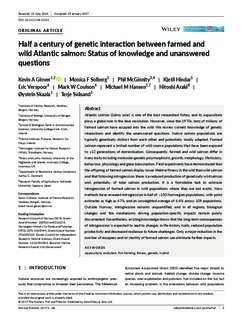Half a century of genetic interaction between farmed and wild Atlantic salmon: Status of knowledge and unanswered questions
Glover, Kevin; Solberg, Monica Favnebøe; McGinnity, Phil; Hindar, Kjetil; Verspoor, Eric; Coulson, Mark W.; Hansen, Michael Möller; Araki, Hitoshi; Skaala, Øystein; Svåsand, Terje
Journal article, Peer reviewed

Åpne
Permanent lenke
http://hdl.handle.net/11250/2443690Utgivelsesdato
2017Metadata
Vis full innførselSamlinger
- Publikasjoner fra CRIStin - NINA [2364]
- Scientific publications [1392]
Originalversjon
10.1111/faf.12214Sammendrag
Atlantic salmon (Salmo salar) is one of the best researched fishes, and its aquaculture
plays a global role in the blue revolution. However, since the 1970s, tens of millions of
farmed salmon have escaped into the wild. We review current knowledge of genetic
interactions and identify the unanswered questions. Native salmon populations are
typically genetically distinct from each other and potentially locally adapted. Farmed
salmon represent a limited number of wild source populations that have been exposed
to ≥12 generations of domestication. Consequently, farmed and wild salmon differ in
many traits including molecular-genetic polymorphisms, growth, morphology, life history,
behaviour, physiology and gene transcription. Field experiments have demonstrated that
the offspring of farmed salmon display lower lifetime fitness in the wild than wild salmon
and that following introgression, there is a reduced production of genetically wild salmon
and, potentially, of total salmon production. It is a formidable task to estimate
introgression of farmed salmon in wild populations where they are not exotic. New
methods have revealed introgression in half of ~150 Norwegian populations, with point
estimates as high as 47%, and an unweighted average of 6.4% across 109 populations.
Outside Norway, introgression remains unquantified, and in all regions, biological
changes and the mechanisms driving population-specific impacts remain poorly
documented. Nevertheless, existing knowledge shows that the long-term
consequences of introgression is expected to lead to changes in life-history
traits, reduced population productivity and decreased resilience to future challenges. Only a major reduction in the number of escapees and/or sterility of farmed salmon can eliminate further impacts.
